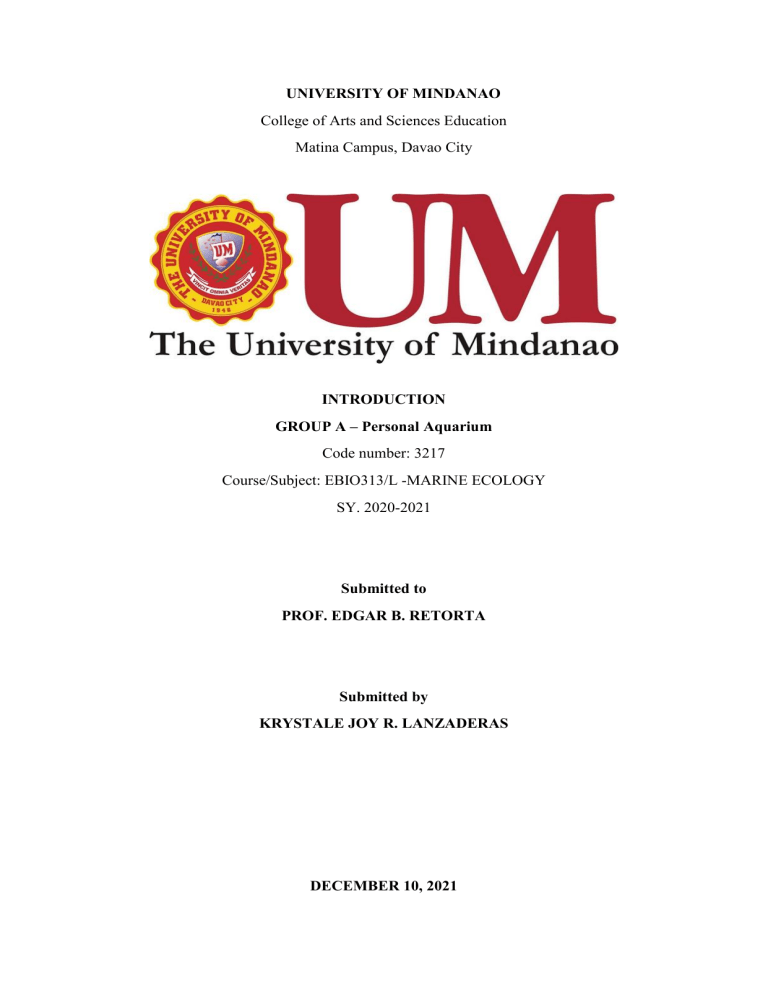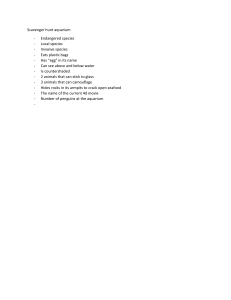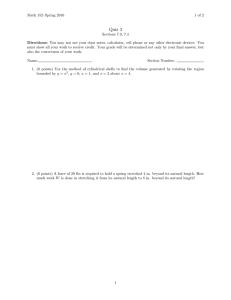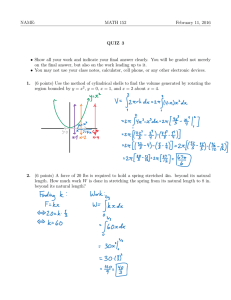
UNIVERSITY OF MINDANAO College of Arts and Sciences Education Matina Campus, Davao City INTRODUCTION GROUP A – Personal Aquarium Code number: 3217 Course/Subject: EBIO313/L -MARINE ECOLOGY SY. 2020-2021 Submitted to PROF. EDGAR B. RETORTA Submitted by KRYSTALE JOY R. LANZADERAS DECEMBER 10, 2021 I. INTRODUCTION The word "fish" refers to a wide range of vertebrates from various evolutionary lines. It also refers to a life form rather than a taxonomic group. Fish, as members of the phylum Chordata, share some common characteristics with other vertebrates. Gill slits, a notochord, or skeletal supporting rod, a dorsal hollow nerve cord, and a tail are all present at some point in the life cycle. Living fishes are classified into five groups, each as distinct as the four groups of familiar air-breathing animals (amphibians, reptiles, birds, and mammals). Any of the approximately 34,000 species of vertebrate animals (phylum Chordata) located in fresh and salt water around the world. The living species range from the primitive jawless lampreys and hagfishes to the cartilaginous sharks, skates, and rays to the abundant and diverse bony fishes. Many fish species are cold-blooded; nevertheless, one species, the opah (Lampris guttatus), is warm-blooded (Weitzman, 2021). In botany, the term "aquarium" was once used to describe a container which is utilized to grow aquatic plants. Although the first recognizable glass aquarium was formulated in 1832 by French-born naturalist Jeanne Villepreux-Power, it was in the works of British naturalist Philip Gosse that the concept first took on its modern meaning as a vessel wherein aquatic animals as well as plants can be retained. An aquarium necessarily requires the maintenance of aquatic species, either freshwater or marine, or a facility where a collection of aquatic organisms is presented or researched. Studying an aquarium is very important in the fields of Marine Biology and Ecology since it contributes to the researchers accumulated knowledge regarding marine life and greatly improves conservation efforts (Rafferty, 2014). According to ACS Distance Education (2011), an aquarium can range from a small round tank with a single fish inside to a large tank with a variety of fish, species, and ornaments to support and create an ecosystem that is both visually appealing and easy to maintain. Those with a wide variety of species are often referred to as "community tanks," and observing different interactions among the different species kept can be a very educational experience. However, assessing species compatibility is an essential factor to be considered if the individual wants to keep a balance between the species and the environment inside an aquarium tank. When it comes to fish behaviour, it is a complex and diverse subject. The nature of an individual fish's response to stimuli from its environment, as in almost all animals with a central nervous system, is determined by the inherited traits of its nervous system, what it has learned from previous experience, and the nature of the stimuli (Fishxperts, 2019). Studying fish behaviour in the aquarium is both an interesting and very helpful activity for the fish keeper. Research into having good pets' natural behaviors will lead to much greater success in keeping and breeding them, as well as open one's eyes to the amazing diversity of fish lifestyles and behavioral adaptations. The main motivation for animal behavior is survival: breeding, finding an appropriate environment, acquiring food, and avoiding predators. Furthermore, even the best-designed aquarium is a poor mimic of nature, so captive fishes should occasionally adapt their behaviors, even if the actual purpose or function of what they are doing can be expected to suffer as a result. With experience, fish keepers will be able to see the connection between the captive's behaviour and its natural counterpart (Indiviglio, 2019). Therefore, fish should be of interest to humans for a variety of reasons, the most vital of which is their relationship with and reliance on the environment. Another more reasonable explanation for the interest in fish is their contribution to the world's food supply, which is modest but significant. This asset, once thought to be limitless, is also now recognized as finite and in delicate balance with the aquatic environment's biological, chemical, and physical factors. Many fish species are useful as experimental or laboratory animals in a variety of medical and biological studies. For instance, the ability of many fishes to adapt to captivity has enabled biologists to study behaviour, physiology, and even ecology under comparatively ecological conditions. Fishes have been particularly significant in the analysis of animal behavior, with research on fishes providing a broad foundation for understanding the more adaptable behavior of higher vertebrates. This scientific study will emphasize between the two different species; (1) Angelfishes (Pterophyllum scalare) and (2) Goldfishes (Carassius auratus) and its behaviour and movement inside the aquarium. Furthermore, the purpose of this scientific experiment is to monitor their survival (breeding, finding an appropriate environment, acquiring food, and avoiding predators) and how it affects their welfare in the aquarium as well as investigate their changes and development brought by their own situated environment. II. OBJECTIVES At the end of this scientific experiment, the researcher will be able to: 1. Identify between the two different species inside the aquarium; and 2. Observe their behaviour and movements. REFERENCES Aquarium of the Pacific (2020). Aquarium Conservation and Research. Retrieved on December 09, 2021 from https://www.aquariumofpacific.org/conservation/research/ ACS Distance Education (2011). Aquarium Management. Retrieved on December 10, 2021 from https://www.acs.edu.au/courses/aquarium-management-636.aspx Fishxperts (2019). Fish Behaviour. Retrieved https://www.fishxperts.com/fish-behavior/ on December 10, 2021 from Indiviglio, F. (2019). Aquarium: Fish Behaviour. Retrieved on December 09, 2021 from https://www.thatpetplace.com/articles/fish-behaviorarticle?fbclid=IwAR26faJ82LMa3tAauVqhiSIPbw9_ia4YNJ0XJ4T8nMPgDeEMBFi SZvBTHaM Rafferty, J. (2011). Aquarium. Retrieved on https://www.britannica.com/science/aquarium December 08, 2021 from Weitzman, S. (2021). Fish Animal. Retrieved on December 08, 2021 from https://www.britannica.com/animal/fish





